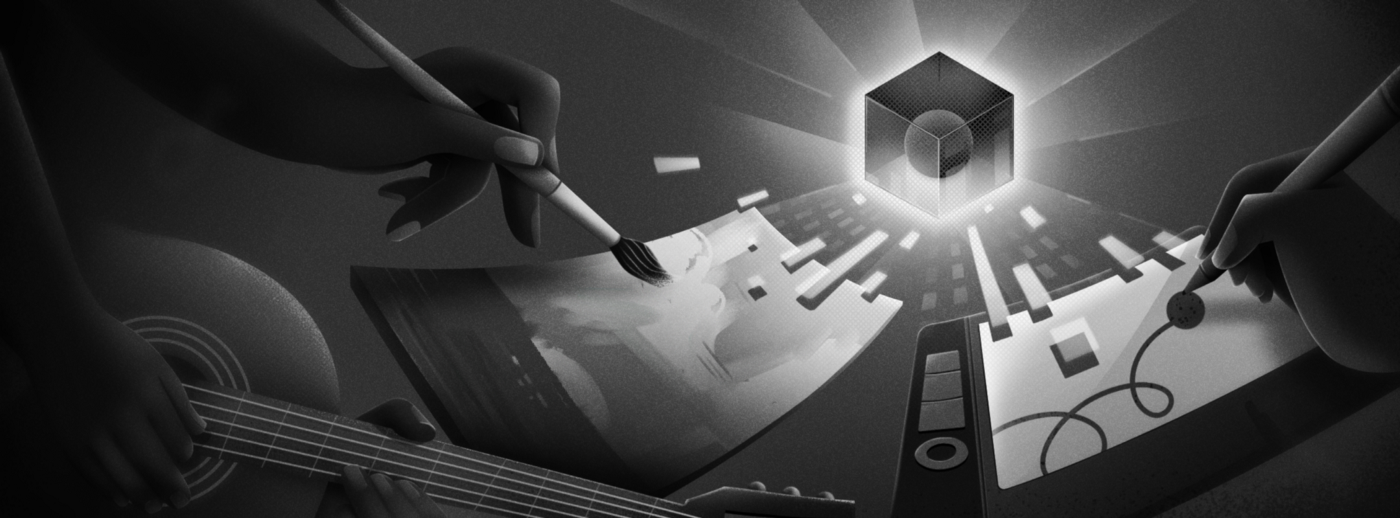Most of the time when mainstream media features NFT’s, it is to discuss the outrageous price that one has recently sold for. But the NFT space is more than billionaires showing off. NFT’s are digital assets which have to be created by, you guessed it, creators! Regardless of medium, any creator, collector, music-listener or human with eyeballs should care deeply about NFT’s.
The shift to make all digital content NFT’s is inevitable. All art, music, movies, comics, youtube videos, workout programs, books, etc. will be NFTs. We are all stakeholders in the future of this space, but the creators, regardless of medium, have the most to lose (or gain! Stay tuned). While we are at the forefront of some truly incredible opportunities for profit sharing and democratization of accessibility, we are also very close to facilitating the continuation of for-profit access control to content.
Investors are throwing money at the development of this space. The future of art, who can access it, and who profits from it are all being decided as we read this. It is critical that artists and consumers advocate for and support decentralized platforms that prioritize the values of the creators before profit…and Darkblock is one of them.
Darkblock is a control panel for decentralized content. Our protocol layer (PeRM: Personal Rights Management) allows creators to choose how their NFT’s are distributed, shown, sold, rented, hidden, destroyed, or unlocked. Users can determine sliced ownership, royalty structures, and inherent properties, all while making sure their creations won’t be copied, distributed, or used outside of their intended purpose.
All creators, from musicians to actors interested in creating digital content should be invested in establishing a decentralized creator economy.
In the beginning, there was Napster.
Historically, musicians were the first to enter the digital space. While peer to peer (P2P) sharing networks like Napster were fantastic for consumers, they were terrible for the artists. So digital rights management (DRM) protocols like Apple Music or Spotify were developed to solve this problem.
The obvious issues with these platforms are that a) artists are not the primary concern of these organizations b) all access is controlled entirely by these companies and lastly, c) the rules of the platform are decided by the companies, not the users. If Apple Music goes bankrupt, where is your music/income? If a platform decides to change its algorithm to promote folk music, the R&B artists have no say.
While most of the traction in the NFT space has been with art, music is the natural next step. In fact, most investors in the NFT space are pushing DRM protocols for music. Although we are starting with art, Darkblock plans to eventually develop a PERM protocol layer for musicians to democratically monetize, sell, and rent their music without a middle man.
You with the paintbrush!
For traditional artists, entering the world of crypto is the next natural step to branching out your business. This shift to the NFT space need not be daunting or contradictory to your beliefs.
Similar to how art is viewed in museums, Darkblock offers a unique experience to the sole owners and collectors of your art. We also allow for the rental of NFTs or owner-authorized sharing, so seeing your digital piece displayed in a temporary exhibition or even permanent slot in a gallery is now a reality.
Not to mention, when a collector does share or sell your work, you see your predetermined share of the profits. This allows for artists to capture an endless portion of revenue streams as you rent your art and earn your deserved share of future sales if your fame grows.
The demand for digital art is here to stay. Most major television brands are offering “artmode” on televisions and museums like UCCA Center for Contemporary Art, Russia’s State Hermitage Museum, and Francisco Carolinum Museum in Linz all have featured NFT exhibitions.
Already a Cryptonative?
Some of you are reading this and already have your NFT’s in circulation. You are most likely already familiar with the limitations of DRM, the prototypes entering the space, and the need for a decentralized protocol to sell your assets. Here is why Darkblock is what you are looking for:
Rarity drives the value of your art — this is true in any market. Darkblock offers additional layers of rarity by encrypting your work for the sole owner. With inspiration from all-digital firsts like Patreon, Darkblock will in time have the ability to offer special access to subscribers or fans of your art, further encouraging the tight-knit community feel of the existing NFT space. We also plan to eventually embed AI and simulations into Darkblocks. This will offer a unique viewing experience limited to the true owner of the content, not just someone copying it online.
As NFT alum, you also are undoubtedly familiar with the limited file formats and sizes of pre-exisiting NFT’s. We allow the creator to upload the original file on-chain up to 350mb, no longer confining artists or sacrificing resolution.
Finally, using Darkblock’s TV app, collectors can also properly display your creations on their devices. While this feature is limited to Samsung TVs currently, it no doubt will expand to other brands soon.
Summary
Darkblock is designed for creators. While the web-app and tv-app are also beneficial to collectors and owners, our goal is to establish a space on the blockchain where the people profiting are the creators themselves. Whether you want to create hidden digital content, rent your pieces, sell for true ownership, or rent your music without DRM, Darkblock facilitates those use cases and more. The decentralized protocol layer (PeRM) gives creators not only control over their work but the platform itself. You decide how the NFT space evolves.
